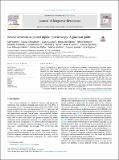Files in this item
Neural networks in pulsed dipolar spectroscopy : a practical guide
Item metadata
| dc.contributor.author | Keeley, Jake | |
| dc.contributor.author | Choudhury, Tajwar | |
| dc.contributor.author | Galazzo, Laura | |
| dc.contributor.author | Bordignon, Enrica | |
| dc.contributor.author | Feintuch, Akiva | |
| dc.contributor.author | Goldfarb, Daniella | |
| dc.contributor.author | Russell, Hannah | |
| dc.contributor.author | Taylor, Michael J. | |
| dc.contributor.author | Lovett, Janet E. | |
| dc.contributor.author | Eggeling, Andrea | |
| dc.contributor.author | Fabregas Ibanez, Luis | |
| dc.contributor.author | Keller, Katharina | |
| dc.contributor.author | Yulikov, Maxim | |
| dc.contributor.author | Jeschke, Gunnar | |
| dc.contributor.author | Kuprov, Ilya | |
| dc.date.accessioned | 2022-04-06T11:34:37Z | |
| dc.date.available | 2022-04-06T11:34:37Z | |
| dc.date.issued | 2022-05 | |
| dc.identifier | 278227658 | |
| dc.identifier | aca8c9d8-556c-44b1-8cb7-01d8b9e41990 | |
| dc.identifier | 85126954799 | |
| dc.identifier | 000821285100002 | |
| dc.identifier.citation | Keeley , J , Choudhury , T , Galazzo , L , Bordignon , E , Feintuch , A , Goldfarb , D , Russell , H , Taylor , M J , Lovett , J E , Eggeling , A , Fabregas Ibanez , L , Keller , K , Yulikov , M , Jeschke , G & Kuprov , I 2022 , ' Neural networks in pulsed dipolar spectroscopy : a practical guide ' , Journal of Magnetic Resonance , vol. 338 , 107186 . https://doi.org/10.1016/j.jmr.2022.107186 | en |
| dc.identifier.issn | 1090-7807 | |
| dc.identifier.other | RIS: urn:013B08DAA26FD4A63099C1FDC1353310 | |
| dc.identifier.other | ORCID: /0000-0002-3561-450X/work/109766684 | |
| dc.identifier.uri | https://hdl.handle.net/10023/25147 | |
| dc.description | This work was funded by a grant from Leverhulme Trust (RPG-2019-048). Studentship funding and technical support from MathWorks are gratefully acknowledged. This research was supported by grants from NVIDIA and utilised NVIDIA Tesla A100 GPUs through the Academic Grants Programme. We also acknowledge funding from the Royal Society (University Research Fellowship for JEL) and EPSRC (EP/R513337/1 studentship for HR and EP/L015110/1 studentship for MJT). | en |
| dc.description.abstract | This is a methodological guide to the use of deep neural networks in the processing of pulsed dipolar spectroscopy (PDS) data encountered in structural biology, organic photovoltaics, photosynthesis research, and other domains featuring long-lived radical pairs and paramagnetic metal ions. PDS uses distance dependence of magnetic dipolar interactions; measuring a single well-defined distance is straightforward, but extracting distance distributions is a hard and mathematically ill-posed problem requiring careful regularisation and background fitting. Neural networks do this exceptionally well, but their “robust black box” reputation hides the complexity of their design and training – particularly when the training dataset is effectively infinite. The objective of this paper is to give insight into training against simulated databases, to discuss network architecture choices, to describe options for handling DEER (double electron-electron resonance) and RIDME (relaxation-induced dipolar modulation enhancement) experiments, and to provide a practical data processing flowchart. | |
| dc.format.extent | 14 | |
| dc.format.extent | 2931259 | |
| dc.language.iso | eng | |
| dc.relation.ispartof | Journal of Magnetic Resonance | en |
| dc.subject | DEER | en |
| dc.subject | PELDOR | en |
| dc.subject | RIDME | en |
| dc.subject | DEERnet | en |
| dc.subject | Neural netowrk | en |
| dc.subject | QA75 Electronic computers. Computer science | en |
| dc.subject | QC Physics | en |
| dc.subject | QD Chemistry | en |
| dc.subject | 3rd-DAS | en |
| dc.subject.lcc | QA75 | en |
| dc.subject.lcc | QC | en |
| dc.subject.lcc | QD | en |
| dc.title | Neural networks in pulsed dipolar spectroscopy : a practical guide | en |
| dc.type | Journal article | en |
| dc.contributor.institution | University of St Andrews. School of Physics and Astronomy | en |
| dc.contributor.institution | University of St Andrews. Biomedical Sciences Research Complex | en |
| dc.identifier.doi | https://doi.org/10.1016/j.jmr.2022.107186 | |
| dc.description.status | Peer reviewed | en |
This item appears in the following Collection(s)
Items in the St Andrews Research Repository are protected by copyright, with all rights reserved, unless otherwise indicated.

